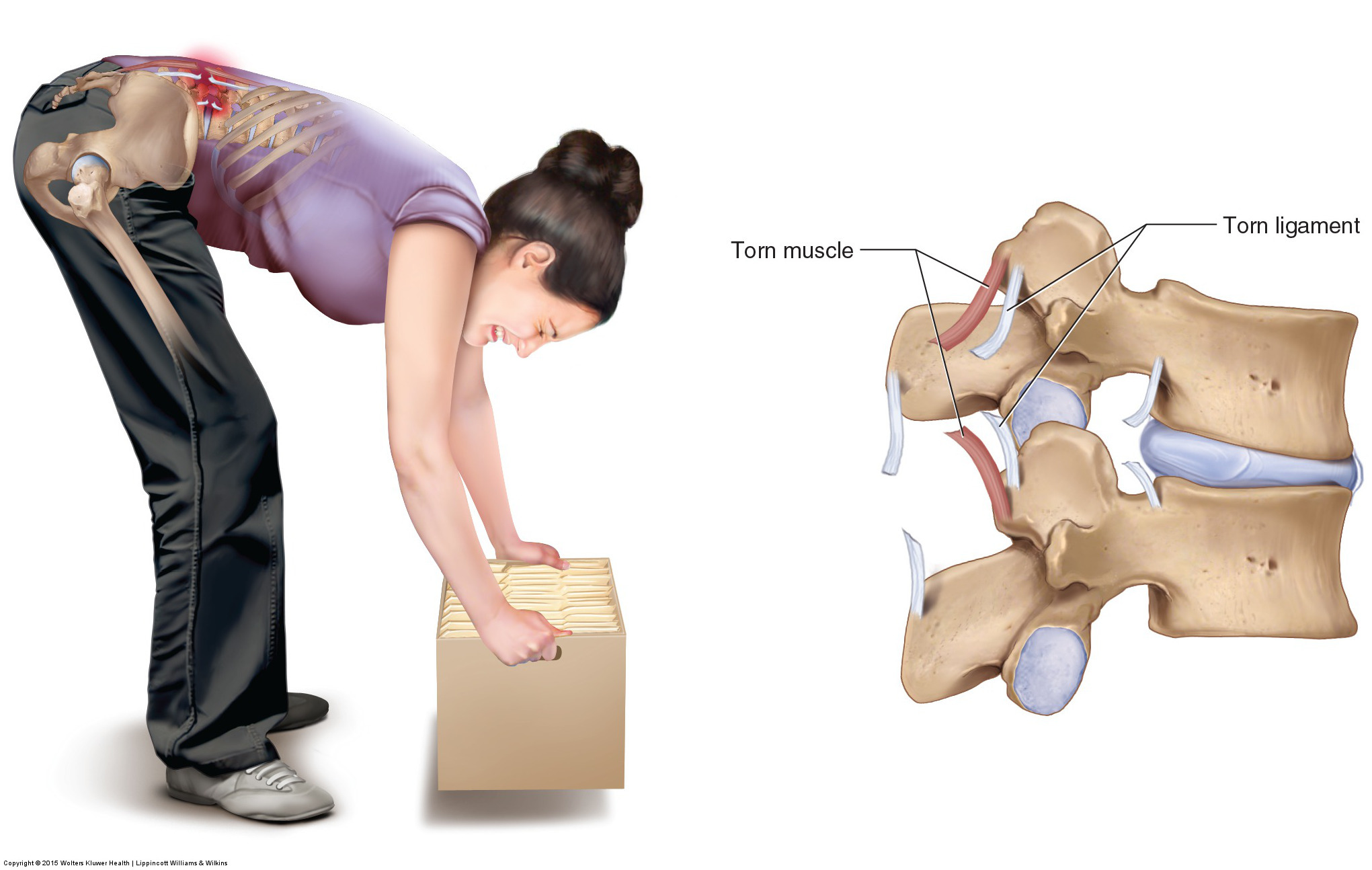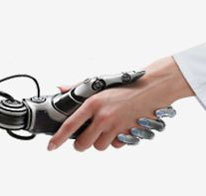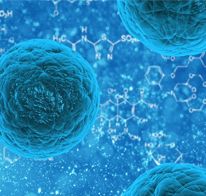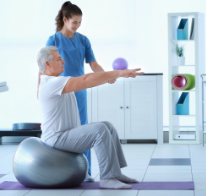Lifting too much weight, physical encounters during strenuous sports, overuse, and fatigue of muscles, twisting or bending improperly. Strains and sprains result in soft tissue damage, small amounts of bleeding into the tissue, inflammation, swelling, bruising, and muscle spasms. Normal living can be severely impacted by such injuries. The pain might be sharp, deep, burning, stabbing, or dull. The pain usually lasts a few weeks, but can become chronic if healing is impaired or a repeat insult occurs.
Spinal muscles that support the vertebrae are the extensors like gluteal muscles, the flexors or abdominal muscles, and the side muscles. Once damage or trauma occurs to a muscle, tendon, or ligament, inflammation and swelling lead to pain that is sent via the nerves. As a result, stiffness can develop which changes the way we move around. Likewise, muscle spasms change our posture and position to limit the spasms. Sometimes, it is hard to stand up straight.
Sprains and Strains

Strains and Sprains
Back pain is very common and is usually in the lower or lumbar region. The lower back is responsible for moving the most weight especially during lifting, twisting, and bending. Sporting injuries, falls, heavy lifting, and accidents can lead to back strain.
A strain is an injury to a muscle that is overstretched or by having to use too much effort to complete the action of lifting an item that is too heavy. It can result in the tendon-muscle connection to be damaged. Cervical muscles near the spine that are commonly strained include the sternocleidomastoid (SCM), the rhomboids, the trapezius, and the levator scapulae. Cervical muscle strains are very common in athletes, but can occur with whiplash.
A sprain is when a ligament (strong bands that hold bones together) is injured (overstretched or torn), and the diagnosis of cervical sprain occurs when the ligamentous structures connecting the cervical facet joints and vertebrae have been damaged. Sprains and strains may be hard to tell apart because sometimes they happen at the same time. Pain, swelling, spasms, and inability to do certain movements are symptoms of strains and sprains
A strain is an injury to a muscle that is overstretched or by having to use too much effort to complete the action of lifting an item that is too heavy. It can result in the tendon-muscle connection to be damaged. Cervical muscles near the spine that are commonly strained include the sternocleidomastoid (SCM), the rhomboids, the trapezius, and the levator scapulae. Cervical muscle strains are very common in athletes, but can occur with whiplash.
A sprain is when a ligament (strong bands that hold bones together) is injured (overstretched or torn), and the diagnosis of cervical sprain occurs when the ligamentous structures connecting the cervical facet joints and vertebrae have been damaged. Sprains and strains may be hard to tell apart because sometimes they happen at the same time. Pain, swelling, spasms, and inability to do certain movements are symptoms of strains and sprains
Patient Education Video
What Causes Back Sprains and Strains?

Example of how heavy lifting with the wrong posture can cause spine damage
How are Strains and Sprains Diagnosed?
Initially, a presumption of strain or sprain is made after less severe trauma occurs to a muscle or joint near the spine. Inability to move might be an initial symptom, but that should improve over time with rest. MRI, CT scan, or X-Rays are not usually ordered unless the symptoms worsen over time or do not improve with rest. These tests can rule out disc problems or a pinched nerve.
How to Treat Sprains and Strains
Bed rest should be limited, but resting the area injured is important. However, complete immobilization can lead to stiffness, loss of muscle mass, and strength. NSAIDs and other analgesics, including muscle relaxers are important in the early stages. Physical therapy (PT) and alternating cold and ice packs.
Physical Therapy may include pelvic traction, gentle massage, electrical muscle stimulation, core strengthening and stretching. This can be continued at home. Medications such as ibuprofen, naproxen, and acetaminophen relieve pain from swelling and inflammation. Besides muscle relaxers, antidepressants and anti-seizure medications can relieve residual nerve pain. Chronic pain can affect your mood and cause anxiety and irritability. Counselling may be effective for emotional symptoms. Acupuncture and biofeedback are two other treatment strategies.
Long-term outlook depends on the precipitating factors such as good posture, sitting in ergonomically supportive chairs, and taking frequent breaks. Yoga, swimming, biking and walking help keep the core abdominal and spinal muscles strong. Keeping body weight at a healthy level and not smoking are important for long-term prevention of future problems. Warming up and stretching before exercise is essential. 90% of people make a full recovery from lumbar muscle sprain or strain.
Physical Therapy may include pelvic traction, gentle massage, electrical muscle stimulation, core strengthening and stretching. This can be continued at home. Medications such as ibuprofen, naproxen, and acetaminophen relieve pain from swelling and inflammation. Besides muscle relaxers, antidepressants and anti-seizure medications can relieve residual nerve pain. Chronic pain can affect your mood and cause anxiety and irritability. Counselling may be effective for emotional symptoms. Acupuncture and biofeedback are two other treatment strategies.
Long-term outlook depends on the precipitating factors such as good posture, sitting in ergonomically supportive chairs, and taking frequent breaks. Yoga, swimming, biking and walking help keep the core abdominal and spinal muscles strong. Keeping body weight at a healthy level and not smoking are important for long-term prevention of future problems. Warming up and stretching before exercise is essential. 90% of people make a full recovery from lumbar muscle sprain or strain.
You should see a specialist if any of the
following symptoms develop:
- Weakness in your legs, a feeling that you might fall when you are walking, or a decrease in the distance that you can walk
- Pain and numbness that radiates down your legs, is worse with sneezing, coughing, or sitting down
- Pain keeps you up at night or is worse lying down
- Fevers associated with the pain
- Numbness in the anus or genital area
- Difficulty urinating, not being able to feel your urine come out, or not able to completely empty
Surgery & Treatment for Sprains and Strains
At Spine Connection we have regenerative and surgical treatments for all spine conditions. As every case is unique we encourage you to receive and compare opinions from our Neurosurgeon and Orthopedic Spine Specialists. We are here to help.
Begin My Assessment
Ask Our Doctors
Join Our Youtube Channel
Watch videos showcasing the latest technologies and surgery techniques, and keep up to date with patient stories from around the globe.








